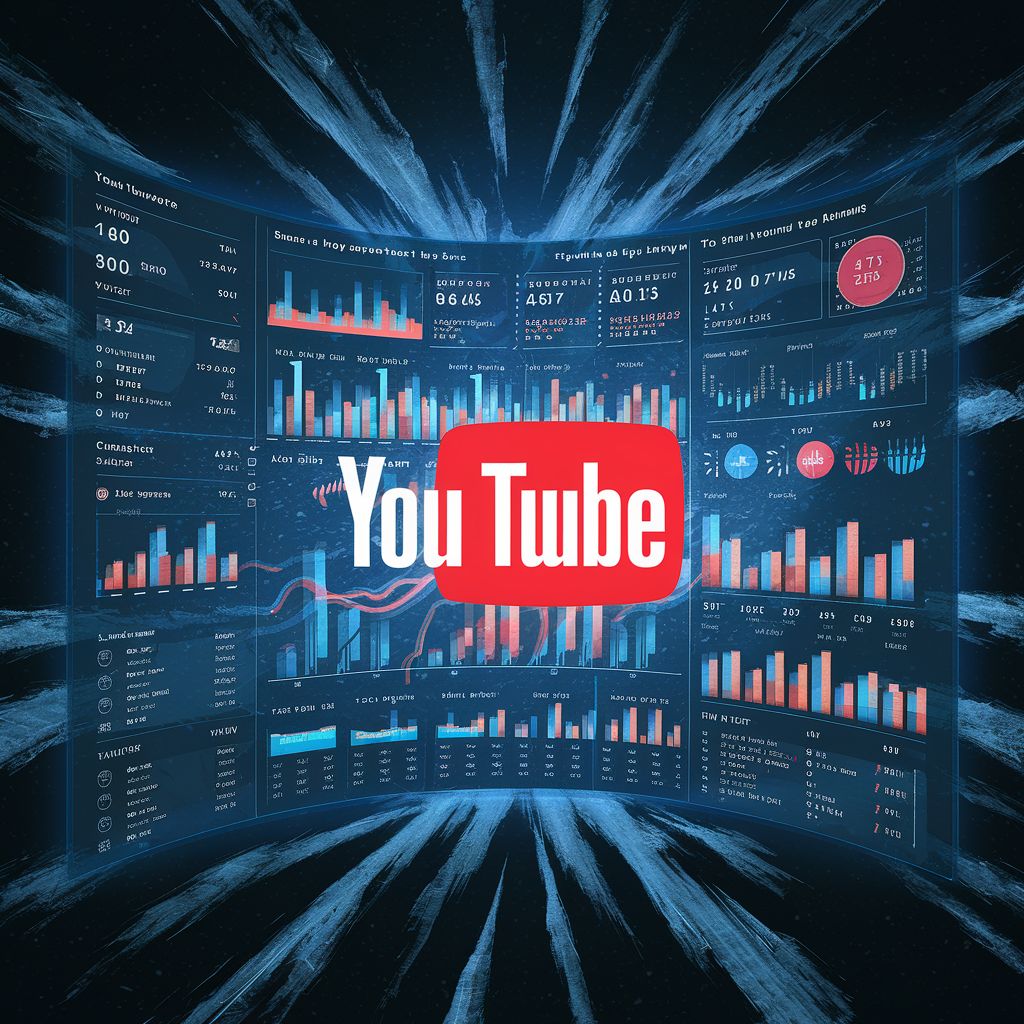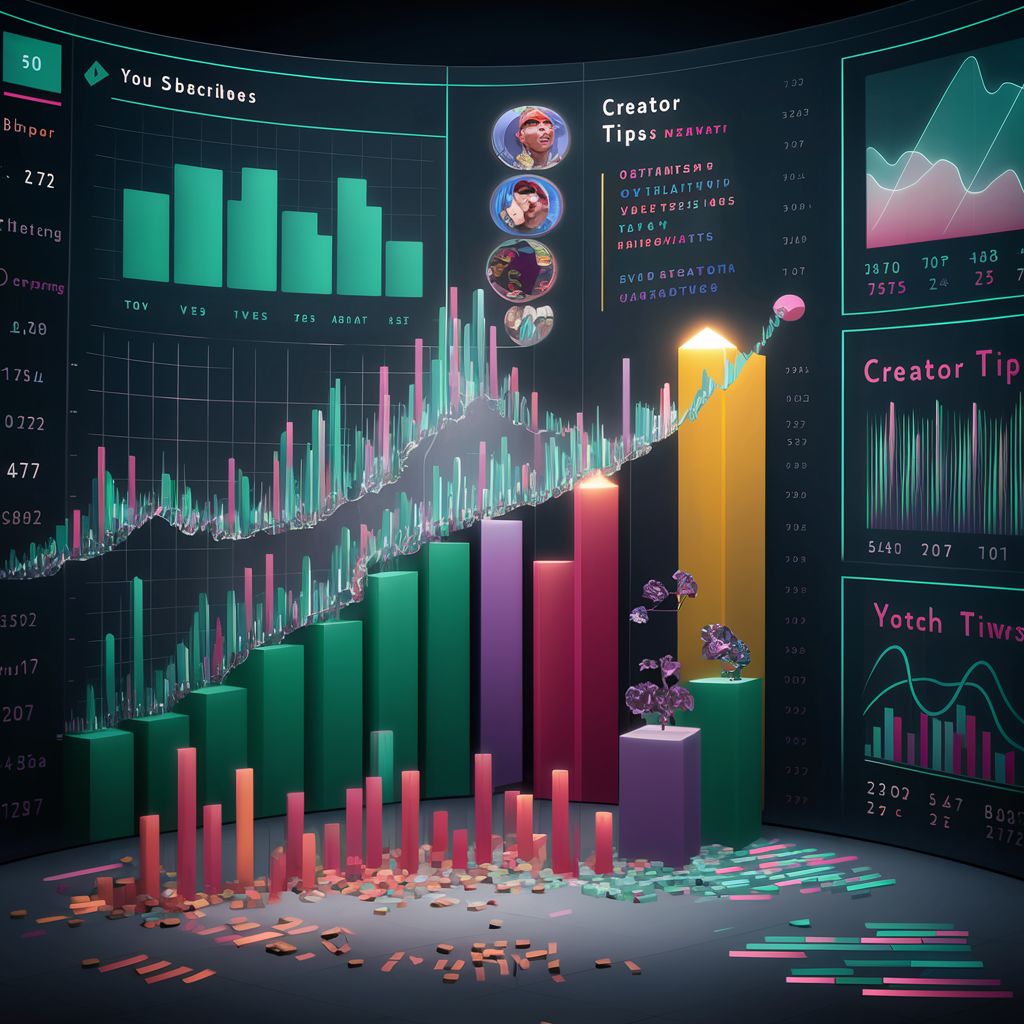How to Track YouTube Views Over Time
Published on 10.04.2024 by Chizoba T
If you want to unlock your YouTube channel's full potential, you should track YouTube views over time. You can do this using the YouTube analytics studio or other third-party tools. However, for the best results, you should understand how to do it. This article will guide you on tracking and making the most of YouTube’s metrics.

YouTube Analytics vs. Third-party Tools
Should you use YouTube Analytics or third-party tools to track YouTube metrics? Here is an overview of both of these options.
YouTube Studio Analytics
If you are a creator, you will have access to the YouTube Studio to help you track the performance of your channel. Some metrics you can view on YouTube Studio are views,watch time, comments, likes, and revenue. The tool will also show your audience demographics, engagement level, and retention rates.
One of the benefits of YouTube analytics is that it is usually integrated with your channel. That means you will see your data without leaving your channel's page. However, its main downside is that you cannot use YouTube Studio to see data from other channels.
Third-Party Analytics tools
There are many YouTube analytics tools that allow you to see your metrics and those of your competitors. Some of the top options are:
- Tubebuddy
- VideoIQ
- Hootsuite
- Social Blade
- Buffer
These tools offer more functionality metrics than the YouTube Studio native tool. They also combine data from different sources, providing a thorough understanding of your online presence. Their downside is that they are usually more complicated and expensive than YouTube Studio. Therefore, you should consider your needs when choosing between them and YouTube Studio.

How to Choose The Right Tool to Track Your YouTube Views Over Time
You should understand how to pick the right tool to track your YouTube views over time. With so many options out there, all with different functionalities and pricing, it can be confusing to do so. Fortunately, we have created a guide to help you choose the right third-party YouTube analytics tool. Here are the key factors you need to consider:
Business Goal
When investing in a YouTube analytics tool, the business goal is a crucial factor you should have in mind. If your goal is to raise awareness of your brand, you need a tool to track reach and views in such an instance. To generate leads and drive conversions, you can also consider a tool that tracks in-depth click-through rates and engagement analytics.
Key Features
As noted earlier, all YouTube analytics tools have different features. Therefore, you need to choose one that fits your desired features. Some of the key functionalities you should consider in a keyword research tool are:
- Keyword research
- Audience demographic
- Competitor tracking
- Trend Analysis
When selecting a tool, consider the most critical features for your business and pick one with such features.
Budget
Again, we noted earlier that YouTube analytics tools are available for a wide range of budgets. Some tools like VideoIQ and TubeBuddy have a free plan that can help you get started with your YouTube analytics. However, such free tools have limited capabilities. The more expensive options have some more sophisticated analytics. When it comes to the budget, you should consider your spending limit and the cost of the tool.

Team Size
Do you have a team that also needs access to YouTube Analytics? If your answer is yes, you need to pick a tool that will give access to many users and allow team collaboration. However, such tools are often more expensive. Therefore, if you are the only one who needs access to YouTube Analytics, you should avoid them.
How to Use YouTube View Data for the Best Results
It's worth noting that subscribers usually watch twice as many videos as non-subscribers. Therefore, if you notice that most of your views aren't coming from subscribers, you may not be making the most of your subscriber base. You should have a consistent posting schedule to let subscribers know when to expect new content.
Analyze Patterns
There are lots of metrics to track, and all show different pictures. However, it becomes easier to get a clearer picture when you analyze patterns. For instance, instead of looking at the click-through rate of one video, you can compare several videos with high CTR. You can then look at the pattern of those videos to determine what you are doing right in them.
Similarly, looking closely at the viewer's duration, you can quickly determine if you meet their expectations when they click your link. If the view duration is too low, you are not delivering what you promised in the title, description, and thumbnail. You may need to revise your strategy significantly if you have changed these elements recently.
Also, keep track of changes in the watch time, as this is a key ranking factor. If your video has a higher watch time, it is more likely to appear in the recommendations and search results, adding eyeballs to the channel. Check if it's possible to determine any patterns causing viewers to stick around or even abandon videos.
You will also need to check patterns when users are online so that you can post more content. The viewing pattern will show you the best time to respond to your viewer's comments.
Track Competitors and Potential Collaborators
By understanding your traffic source, you can see collaboration ideas and competitors trying to outrank you. To see these details, click on how viewers see your video>Suggested videos. This will show you the kind of videos in your niche appearing in suggested videos. Since they already bring viewers your way, they can be suitable for collaboration ideas.
On the other hand, remember that the suggested videos are part of the YouTube algorithm; therefore, the videos can also be your competitors. You should, therefore, check their content and analyze it using a YouTube analysis tool. This will help you determine if these are competitors or foes.

You should also check the report on the content your audience watches to see whether it's related to your niche. You don't have to compete even if you target the same audience. Instead, you can see if there are opportunities for unique collaboration ideas.
Leverage Your Best Videos
By looking at the YouTube analytics, you can quickly tell the areas you should pay special attention to. Check if there are videos that YouTube suggests on their homepage. Traffic from such videos will likely visit your channel for the first time. Therefore, you can put more effort into ranking your videos on the suggested page to increase YouTube views.
It would be a great idea to reshuffle your videos so that the most popular videos with the highest view rate remain at the top. Not only will these videos bring new traffic, but they will increase the number of viewers for your new videos.
Tips On Getting Better Results When Tracking YouTube Views
To help you get the best results, use these tips:
Set Up YouTube Analytics
If you need accurate data, you must ensure you have set your tracking and analytics well. This also involves connecting your YouTube channel with your favorite tool. You will also need to connect the YouTube channel to your analytics program to set your site's tracking tags and codes correctly.
Understand the Right Metrics to Focus On
There are so many metrics to track on YouTube that it can be hard to determine which to pay attention to and which to ignore. However, there are important ones you should not ignore, as these impact the growth of your channel. These are:
- Views
- Watch time
- Audience demographics
- Engagement
By tracking these key metrics, you can better determine your success and make data-driven decisions to optimize your channel. Such decisions will also make it easy for you to make money on YouTube.
Analyze Regularly
You should track and analyze data regularly to get the most out of YouTube analytics data. With content strategies changing rapidly, you cannot assume that what worked in the past will continue working. For instance, if you notice a sudden increase in subscribers; you might want to check deeply into the numbers to see what is causing the sudden spike.
Change Video Strategy According to Data
You should keep tracking your data and changing your content strategy accordingly. This will help you to determine the:
- Kind of videos bringing success to your channel.
- Topics resonating with your audience.
- Content with the highest interaction rate.
With this knowledge, you can change your videos to make them more interactive. In return, you will get more views and more engagement.
How to Use Competitor Analysis to Optimize Your Content
Competitor analysis is a key part of YouTube marketing. By comparing your videos to those of the competitors, you can quickly identify gaps and opportunities in your industry. This can also give you a better idea of:
- The kind of content trending in your niche.
- Audience base of your competitors.
- Elements adding success to their videos.
To perform YouTube competitor analysis, you can follow these steps:
Identify the Competitors in Your Industry
Find videos with the same content using the YouTube search bar to determine your competitors. You can do that by using the keywords you are targeting. You can watch videos of companies promoting similar products if you are a brand or using the same keyword if you have a content marketing agency.
You can also use keyword research tools such as Ahref or Semrush for competitor analysis. This will help you see the potential volume of a keyword and the auxiliary content to target.
Review the Video Content of Your Competitors
Go through your competitor's videos while checking for the following:
- The type of videos they are creating: tutorials, reviews, vlogs, etc.
- The content that is getting the highest engagement.
- How their audience is receiving their content.
- How often are they publishing content?
- The length of their videos.
- Their most popular videos from last year.
- Do they have a video series or a recurring theme?
- Do the competitors use interactive elements such as end screens, polls, and clickable links?
- How do they organize their playlists?
- What visual styles are they using in their thumbnails?
After collecting and aggregating this data, you can use it to identify and note any recurring themes. If their videos receive a high view count and positive engagement, their content resonates well with their audience. It also indicates that you can succeed by borrowing from their content strategy and doing better content than them.
For instance, if your competitor uses brand storytelling with their videos and receives many views for such videos, you can also try the same strategy. You can turbocharge your research using freemium tools like BuzzSumo and TubeBuddy.

Identify their SEO Keywords and Strategies
One of the key areas in YouTube competitor analysis is watching their video titles, descriptions, and tags. This will help you determine how they optimize their videos for YouTube search. Use keyword research tools like VideoIQ and TubeBuddy to help you see the search volume of their target keywords.
Video Titles
Some of the issues to check on their video titles are:
- How do they structure different competing videos?
- Are there some common keywords they are using in their titles? These keywords can be an indication of the topics that are resonating with their audience.
This research will also help you determine how to structure your video style and the keywords you should use in them.
Description
You also need to analyze your competitor's videos. Check their structure and whether they include links, relevant keywords, and additional information. This is what will inform your keyword description.
Look at Viewers' Engagements
Viewers' comments are another resource commonly ignored when doing competitor analysis but are very useful. Check for patterns in how users engage in the comments section, polls, or feedback. You should check if your competitors are partnering with other creators.
Also, consider if your competitors have several questions in the comment sections that they haven't answered. This will give you insights on topics you can cover in your next video. You can then actively engage with your audience.
You can tell how the content was received by looking at viewer engagement, such as likes. For instance, if you see a video with many views but limited likes, it may be a sign that viewers don't like the video. Therefore, by reviewing viewers' comments and likes on competitor videos, you can get a lot of insight into what the viewers like or don't.
Even as you do competitor analysis, remember that this doesn't mean copying your competitor's idea or completely copying their channels. YouTube loves unique video ideas, and viewers don't need another video that looks exactly like the one they viewed. Therefore, you should create stunning and original YouTube videos that will provide value to your viewers.
Create Unique Content
After doing a competitor analysis, you need to implement the ideas you picked. From the analysis, you can see where your competitors fall short. These are the content gaps that you will be using for inspiration. For instance, if you noted that your competitors are creating long videos without elements, this is an area you can create content on while adding the elements. By doing that, you will easily stand out from the competition and rank YouTube videos well.

Conclusion
You can use YouTube analytics to better understand the performance of your videos and channels. This is because you can see all your channel's metrics and competitors. However, you must know how to track YouTube views over time for the best result. By using our guide, you can improve your YouTube marketing.